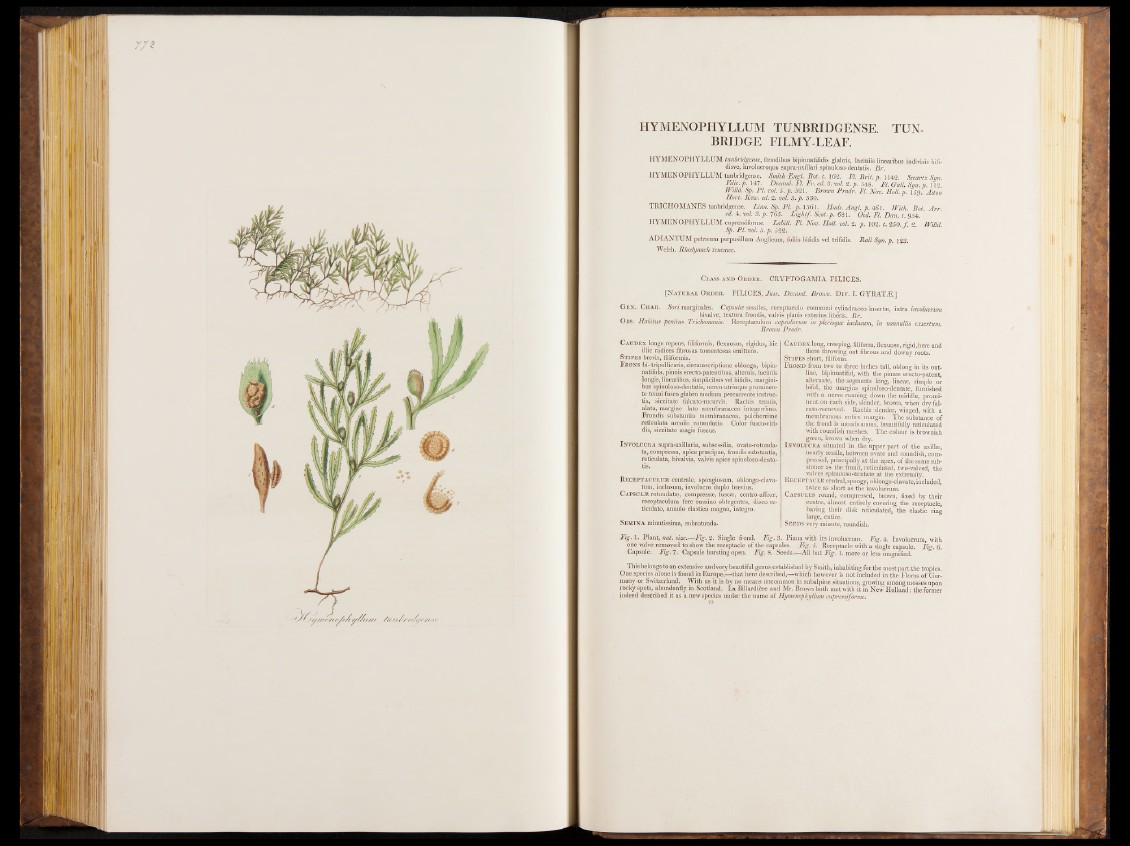
HYMENOPHYLLUM TUNBRIDGENSE. TUNBRIDGE
FILMY-LEAF.
HYMENOPHYL LUM tunbridgense, frondibus bipinnatifrdis glabris, laciniis linearibus indivisis bifi-
disve, involucroque supra-axillari spinuloso-dentatis. B r .
HYMENOPHYL LUM tunbridgense. Smith Engl. Bot. t. 162. Ft. B rit. p. 1142. Swartz Sun.
Filic. p. 147. Decand. Fl. Fr. ed. 3. vol. 2. p. 548. FI. Gall. Sun. p. 112.
Willd. Sp. PI. vol. 5. p. 521. Brown Prodr. Fl. Nov. Holl.p. 159. Alton
Hort. K m . ed. 3,. vol. 5 .p . 530.
TRICHOMANES tunbridgense. Linn. Sp. PI. p. 1561. Huds. Angl. p. 461. With. Bot. A rr.
ed. 4. vol. 3. p. 765. Lig h t/. Scot. p. 681. Oed. Fl. Dan. t. 954. ’
H YM ENOPHYL LUM cupressiforme. Labill. Fl. Nov. Holl. vol. 2. p. 102. t. 250. f. 2. Willd.
Sp. PI. vol. 5. p. 522.
ADIA N TUM petrasum perpusillura Anglicum, foliis bifidis vel trifidis. R aii Syn. p. 123.
Welsh. Rhedynach teneuwe.
Class and Ord e r . CRYPTOGAMIA FILICES.
[Natural Ord e r . FIL ICE S, Juss. Decand. Brawn. D iv . I. GYRATÆ.J
G e N. Ch ar. Sori marginales. Capsulæ sessiles, receptaculo communi cylindraceo insertæ, intra involucrum
bivalve, textura frondis, valvis planis exterius liberis. B r .
Obs. Habitus penitus Trichomanis. Receptaculum capsularum in plerisque inclusum, in nonnullis exsertum.
Brown Prodr.
Caudex longe repens, filiformis, flexuosus, rigidus, hie
illic radices fibrosas tomentosas emittens.
St ipe s brevis, filiformis.
F rons bi- tripollicaris, circumscriptione oblonga, bipin-
natifida, pinnis erecto-patentibus, alternis, laciniis
longis, linearibus, simplicibus vel bifidis, margini-
bus spinuloso-dentatis, nervo utrinque prominente
tênui fusco glabro medium percurrente instruc-
tis, siccitate falcato-recurvis. Rachis tenuis,
alata, margine lato membranaceo integerriino.
Frondis substantia membranacea, pulcherrime
reticulata areolis. rotundatis. Color fusco-viri-
dis, siccitate magis fuscus.
INVOLUCRA supra-axillaria, subsessilia, ovato-rotunda-
ta, compressa, apice pnecipue, frondis substantia,
reticulata, bivalvia, valvis apice spinuloso-dentatis.
R eceptaculum centrale, spongiosum, oblongo-clava-
tum, inclusum, involucro duplo brevius..
Ca psuiæ rotundatæ, compressas, fuscæ, centro affixæ,
receptaculum fere omnino obtegentes, disco re-
ticulato, annulo elastico magno, integro.
Semin a minutissima, subrotunda.
Caudex long, creeping, filiform, flexuose, rigid, here and
there throwing out fibrous and downy roots.
St ipe s short, filiform.
Frond from two to three inches tall, oblong in its outline,
bipinnatifid, with the pinnas erecto-patent,
alternate, the segments long, linear, simple or
bifid, the margins spinuloso-dentate, furnished
with a nerve running down the middle, prominent
on each side, slender, brown, when dry fal-
cato-recurved. Rachis slender, winged, with a
membranous entire margin.- The substance of
the frond is membranous, beautifully reticulated
with roundish meshes. The colour is brownish
green, brown when dry.
INVOLUCRA situated in the upper part of the axillas,
nearly sessile, between ovate and roundish, compressed,
principally at the apex, of the same substance
as the frond, reticulated, two-valved, the
valves spinuloso-dentate at the extremity.
Receptacle central, spongy, oblongo-clavate, included,
twice as short as the involucrum.
Capsules round, compressed, brown, fixed by their
centre, almost entirely covering the receptacle,
having their disk reticulated, the elastic ring
large, entire.
Seeds very minute, roundish.
Fig. 1. Plant, nat. size.—Fig. 2. Single frond., F ig.S. Pinna with its involucrum. F ig .4. Involucrum with
one valve removed to show the receptacle of the capsules. Mg. 5. Receptacle with a single capsule. Fig. 6.
Capsule. Fig. 7. Capsule bursting open. Fig. 8. Seeds.—All but Fig. 1. more or less magnified.
This belongs to an extensive and very beautiful genus established by Smith, inhabiting for the most part the tropics.
One species alone is found in Europe,—that here described,—which however is not included in the Floras of Germany
or Switzerland. With us it is by no means uncommon in subalpine situations, growing among mosses upon
rocky spots, abundantly in Scotland. La Billardibre and Mr. Brown both met with it in New Holland: the former
indeed described it as a new species under the name of Hymenophyllum cupressiforme.